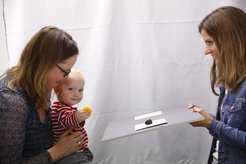Choice and Reaching Tasks
Infants’ reaching behavior can be as informative as their visual attention. Choice paradigms present two objects to infants simultaneously and use infants’ reaching behavior as an indication of their preference for one object over the other.

Many of our studies use a “time-to-touch” paradigm in which we measure infants’ latency to touch individual objects that are presented serially, as well as measuring their subsequent exploration of each object. By comparing how infants touch different types of stimulus objects, we can make inferences about the types of objects infants avoid. In general, we present all of our stimulus objects for a given study to each participant to account for individual differences in reaching behavior. We also randomize the order in which the objects are presented across participants to mitigate order effects.
